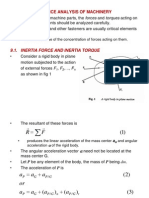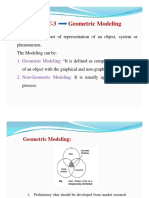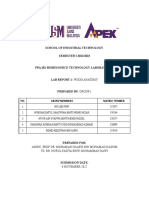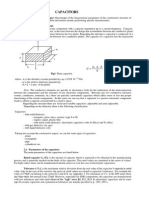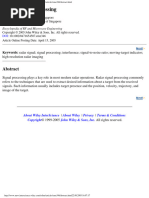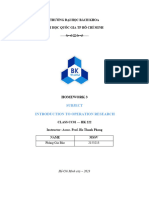Micro Machining
Micro Machining
Uploaded by
Chandana KotaCopyright:
Available Formats
Micro Machining
Micro Machining
Uploaded by
Chandana KotaCopyright
Available Formats
Share this document
Did you find this document useful?
Is this content inappropriate?
Copyright:
Available Formats
Micro Machining
Micro Machining
Uploaded by
Chandana KotaCopyright:
Available Formats
Refers to techniques for fabrication of 3D structures on the micrometer scale Most methods use silicon as substrate material Some
of process involved in this are photolithography, etching, bulk machining, laser machining etc. Unit metal removal rate and equipment precision are key factors to micro machining.
The wafers are chemically cleaned to remove particulate matter, organic, ionic, and metallic impurities High-speed centrifugal whirling of silicon wafers known as "Spin Coating" produces a thin uniform layer of photo resist (a light sensitive polymer) on the wafers. Photoresist is exposed to a set of lights through a mask often made of quartz Two types of photoresist are used: Positive: whatever shows, goes Negative: whatever shows, stays
Negative and Positive Photoresists
Photoresist Substrate UV light
Mask/reticle Photoresist
Substrate
Negative Photoresist Substrate Positive Photoresist Substrate
Exposure
After Development
Etching is used in micro fabrication to chemically remove layers from the surface of a wafer during manufacturing. For many etch steps, part of the wafer is protected from the etchant by a "masking" material which resists etching. In some cases, the masking material is a photo resist which has been patterned using photolithography. Other situations require a more durable mask, such as silicon nitride. These are of two types. They are 1)dry etching 2)wet etching In wet etching these are of two types 1)isotropic 2)anisotropic
WET ETCHING: The wafer can be immersed in a bath of etchant, which must be agitated to achieve good process control. For instance, buffered hydrofluoric acid (BHF) is used commonly to etch silicon dioxide over a silicon substrate. A perfectly isotropic etch produces round sidewalls. A perfectly anisotropic etch produces vertical sidewalls. Red: masking layer; yellow: layer to be removed Anisotropic wet etching: Some wet etchants etch crystalline materials at very different rates depending upon which crystal face is exposed.
DRY ETCHING:
Modern VLSI processes avoid wet etching, and use plasma etching instead. The plasma produces energetic free radicals, neutrally charged, that react at the surface of the wafer. Since neutral particles attack the wafer from all angles, this process is isotropic. In this plasma contains a source gas which are rich in chlorine and fluorine such as carbontetraflouride in between electrodes and the wafer is etched.
Uses anisotropic etching of single crystal silicon Bulk micromachining is a process used to produce micro machinery or microelectromechanical systems (MEMS). Common chemicals used in anisotropic etching processes are: Potassium hydroxide (KOH)/H2O solutions, sometimes with ispropyl alcohol (IPA) additive at 65-85CEthylene diamine pyrocatechol (EDP), diluted with water at 115C Tetra methyl ammonium hydroxide (TMAH) and water at 90C Hydrazine N2H4/H2O/IPA at 115C
High-power laser pulses are used to evaporate matter from a target surface A supersonic jet of particles (plume) is ejected normal to the target surface which condenses on substrate opposite to target. The ablation process takes place in a vacuum chamber- either in vacuum or in the presence of some background gas Excimer and Femto lasers are power source in this techniques When high intensity laser is incident on the work piece it will remove the material by vaporization
Highly flexible. Few processing steps. Capable serial or batch mode production. High quality products are produced. Good surface finish. Applicable to any type of material like polymer, glasses, crystals. Material removal rate is minimum which is main advantage for the machining at micrometer scale. Ability to machine flat and contoured surfaces.
Expensive equipment required in laser micro machining Surface ripples due to shock waves are formed in laser micromachining. Maintaining of high quality and high accuracy is difficult Maintaining high pressure, high degrees of thermal variability makes micromachining costly There is high potential radiation damage on the surface of wafer in bulk machining.
Manufacturing of MEMS parts. In Biochip manufacture using laser machining. Laser ablation is commonly used for patterning thin films to produce small features or isolate regions within a device. Applications of laser ablation of thin films includes production of photovolatic cells. Drilling fine pitch vertical probe cards for semiconductor testing. Laser machining of the holes in fuel injector nozzles guarantees accuracy and high quality .
You might also like
- Grabb and Smith's Plastic Surgery, 7th EditionDocument1,050 pagesGrabb and Smith's Plastic Surgery, 7th EditionPuput Pujiama82% (33)
- Productivity and Reliability-Based Maintenance Management, Second EditionFrom EverandProductivity and Reliability-Based Maintenance Management, Second EditionNo ratings yet
- Computer Introduction To C ReportDocument6 pagesComputer Introduction To C ReportsrijaNo ratings yet
- White Paper To Mok - FINAL-1Document26 pagesWhite Paper To Mok - FINAL-1William Mook67% (3)
- Unit Iii Visual RealismDocument59 pagesUnit Iii Visual RealismJabin JoeNo ratings yet
- Introduction To Solid Modeling PDFDocument50 pagesIntroduction To Solid Modeling PDFPetre Penda Auala100% (1)
- Reddy, K. Venkata.-Textbook of Engineering Drawing, Second Edition-BS Publications (2008)Document10 pagesReddy, K. Venkata.-Textbook of Engineering Drawing, Second Edition-BS Publications (2008)Damodar ReddyNo ratings yet
- Brouchure AICTE ATAL FDP On 3D Printing in Industry 4.0Document2 pagesBrouchure AICTE ATAL FDP On 3D Printing in Industry 4.0Vasanthan BNo ratings yet
- 3D Printing Unit 3Document62 pages3D Printing Unit 3Aman SinghNo ratings yet
- Question: A Robotic Work Cell Has A Camera With in The Setup. The Origin ofDocument2 pagesQuestion: A Robotic Work Cell Has A Camera With in The Setup. The Origin ofAnmol Thakur AstNo ratings yet
- Engineering Seminar Topics:: Seminar Paper: 3D Printing TechnologyDocument6 pagesEngineering Seminar Topics:: Seminar Paper: 3D Printing TechnologyAyush SinghalNo ratings yet
- Automation of Ac System Employing PLC and ScadaDocument10 pagesAutomation of Ac System Employing PLC and Scadaeyob feshaNo ratings yet
- 1 6 A Discoverengineering 1Document6 pages1 6 A Discoverengineering 1api-264758535No ratings yet
- Metrology ICS Lab Manual A.y-2018-19Document93 pagesMetrology ICS Lab Manual A.y-2018-19chandrarao chNo ratings yet
- 117ar - Automation in Manufacturing PDFDocument8 pages117ar - Automation in Manufacturing PDFvenkiscribd444No ratings yet
- CAD/CAM - Objective Questions - Unit2Document2 pagesCAD/CAM - Objective Questions - Unit2Anonymous YkDJkSqNo ratings yet
- Lecture-8 Microsystems Fabrication Processes - PPTDocument57 pagesLecture-8 Microsystems Fabrication Processes - PPTSairam.K100% (1)
- Cad/cam NotesDocument21 pagesCad/cam NotesS A ABDUL SUKKURNo ratings yet
- 2 Marks With AnswersDocument16 pages2 Marks With AnswersKarthik SoundarrajanNo ratings yet
- CC7202-Integrated Product Design and Process DevelopmentDocument8 pagesCC7202-Integrated Product Design and Process DevelopmentPooja MNo ratings yet
- Scaling Laws and Multiscale ManufacturingDocument32 pagesScaling Laws and Multiscale ManufacturingVikas Lakhmani100% (1)
- Computer Application in DesignDocument1 pageComputer Application in DesignAntony PrabuNo ratings yet
- Wear Debris Analysis: Department of Mechanical EngineeringDocument18 pagesWear Debris Analysis: Department of Mechanical EngineeringOmkarNo ratings yet
- CappDocument14 pagesCappDerik Nelson100% (1)
- Fundamentals of Additive Manufacturing Technologies - Unit 4 - Week 2 - Computer Aided Process Planning For Additive ManufacturingDocument3 pagesFundamentals of Additive Manufacturing Technologies - Unit 4 - Week 2 - Computer Aided Process Planning For Additive ManufacturingSaurav KumarNo ratings yet
- BCPE Sample Questions Answers July 2021Document13 pagesBCPE Sample Questions Answers July 2021daniyalc47100% (1)
- Ed9221-Finite Element Methods in Mechanical Design-R8Document2 pagesEd9221-Finite Element Methods in Mechanical Design-R8Bakkiya RajNo ratings yet
- Lapping Process - Definition, Working Principle, Types, Material, Advantages, Application (Notes With PDF) - Learn MechanicalDocument13 pagesLapping Process - Definition, Working Principle, Types, Material, Advantages, Application (Notes With PDF) - Learn MechanicalMirko DujmićNo ratings yet
- Join Notation SchemeDocument2 pagesJoin Notation SchemeChilton FernandesNo ratings yet
- Mechanical Problems Associated With Surface Micromachining: Class 7Document24 pagesMechanical Problems Associated With Surface Micromachining: Class 7ShankarAthava100% (1)
- Force Analysis of Machinery: 9.1. Inertia Force and Inertia TorqueDocument16 pagesForce Analysis of Machinery: 9.1. Inertia Force and Inertia TorqueaddisudagneNo ratings yet
- Rapid PrototypingDocument42 pagesRapid PrototypingsandeepthehappiestNo ratings yet
- CE6451 SCAD MSM by WWW - Learnengineering.inDocument166 pagesCE6451 SCAD MSM by WWW - Learnengineering.intech guyNo ratings yet
- Computer Aided Process Planning-Objective Questions - Unit4Document1 pageComputer Aided Process Planning-Objective Questions - Unit4Anonymous YkDJkSqNo ratings yet
- MF7203-Dec 16 THEORY-OF-METAL-FORMINGDocument3 pagesMF7203-Dec 16 THEORY-OF-METAL-FORMINGupender100% (1)
- Cad Cam Syllabus PDFDocument2 pagesCad Cam Syllabus PDFBrijesh Kumar ChaurasiyaNo ratings yet
- MCQs of Introduction To Metrology, Linear and Angular Measurement (Mechanical MDocument4 pagesMCQs of Introduction To Metrology, Linear and Angular Measurement (Mechanical MAbhishek Yadav100% (1)
- Autonomous Vehicle Systems SyllabusDocument2 pagesAutonomous Vehicle Systems Syllabusapi-371659470No ratings yet
- Lecture Notes Set 2 - Designing Mechatronic SystemsDocument14 pagesLecture Notes Set 2 - Designing Mechatronic SystemsMark AzzopardiNo ratings yet
- Technical Seminar Presentation HarishDocument21 pagesTechnical Seminar Presentation Harishprashanth nNo ratings yet
- Unit 4 Ucmp MCQDocument10 pagesUnit 4 Ucmp MCQmhd slmnNo ratings yet
- Lab Manual 2 PrintDocument17 pagesLab Manual 2 Printmonikandakumar ramachandranNo ratings yet
- Tolerance AnalysisDocument24 pagesTolerance AnalysisJayachandra PelluruNo ratings yet
- MCE 417 Course CompactDocument7 pagesMCE 417 Course CompactKEHINDE BABALOLANo ratings yet
- Automation in Manufacturing 10ME757: Department of Mechanical Engineering, SIRMVIT (Ramesh C G & Hanamantraygouda M B)Document193 pagesAutomation in Manufacturing 10ME757: Department of Mechanical Engineering, SIRMVIT (Ramesh C G & Hanamantraygouda M B)Wtf rajuNo ratings yet
- Back Face DetectionDocument9 pagesBack Face DetectionSinduja Baskaran100% (1)
- Robotics - Orientation & PO Mapping AttainmentDocument12 pagesRobotics - Orientation & PO Mapping AttainmentsiddeshsdNo ratings yet
- CAD CAM Unit - 3 PPT-ilovepdf-compressedDocument66 pagesCAD CAM Unit - 3 PPT-ilovepdf-compressedTaha SakriwalaNo ratings yet
- Lecture 27 Intro Slipline Field TheoryDocument14 pagesLecture 27 Intro Slipline Field TheoryprasannaNo ratings yet
- Forging - Machine Tools Questions and Answers - SanfoundryDocument6 pagesForging - Machine Tools Questions and Answers - SanfoundryrahmaNo ratings yet
- ME3393 Manufacturing Processes 03 - by LearnEngineering - inDocument37 pagesME3393 Manufacturing Processes 03 - by LearnEngineering - inUrbhi SahaNo ratings yet
- Chapter 3 PG MetrologyDocument3 pagesChapter 3 PG MetrologyramptechNo ratings yet
- 2.1. Representation of Curves: Geometric ModelingDocument88 pages2.1. Representation of Curves: Geometric ModelingSrinith KumarNo ratings yet
- Department of Mechanical Engineering: Laboratory ManualDocument52 pagesDepartment of Mechanical Engineering: Laboratory ManualMECHANICAL SMCETNo ratings yet
- FDP Brochure-3D PrintingDocument2 pagesFDP Brochure-3D Printingravi_2008No ratings yet
- Question Bank-CADDocument6 pagesQuestion Bank-CADsudeep thotaNo ratings yet
- D-Alembert Principle and Lagrange's EquationsDocument9 pagesD-Alembert Principle and Lagrange's EquationsShakeel Ahmad KasuriNo ratings yet
- GDJP Important 2 Marks and 16 Marks With AnswerDocument18 pagesGDJP Important 2 Marks and 16 Marks With AnswerMechanical Engg DeptNo ratings yet
- Damage Mechanics in Metal Forming: Advanced Modeling and Numerical SimulationFrom EverandDamage Mechanics in Metal Forming: Advanced Modeling and Numerical SimulationRating: 4 out of 5 stars4/5 (1)
- Micro MachiningDocument18 pagesMicro MachiningSUMEET SINGHNo ratings yet
- MEMS CAT 2 SolvedDocument10 pagesMEMS CAT 2 SolvedTrinayan PathakNo ratings yet
- MicromachiningDocument51 pagesMicromachiningManoj MurthyNo ratings yet
- Simplified Solution of Space Frame Structures.: Hayen, Charles LeoDocument77 pagesSimplified Solution of Space Frame Structures.: Hayen, Charles LeoJD OngNo ratings yet
- SG3400 3125 2500HV-20 PDFDocument1 pageSG3400 3125 2500HV-20 PDFnalvaro88No ratings yet
- Prepositions and Numbers RevisionDocument31 pagesPrepositions and Numbers RevisionArija EverdinNo ratings yet
- Lab Report 1 Iwa 282Document25 pagesLab Report 1 Iwa 282Lp NgNo ratings yet
- BQ Earthworks (Priced) .Rev7Document15 pagesBQ Earthworks (Priced) .Rev7Tan Ching0% (1)
- C73x-X73x-C74x-X74x PS FRUs Module Rev1.0Document8 pagesC73x-X73x-C74x-X74x PS FRUs Module Rev1.0Pedro MachadoNo ratings yet
- Evaluation of Damping in Dynamic Analysis of StructuresDocument4 pagesEvaluation of Damping in Dynamic Analysis of StructuresMarian PopescuNo ratings yet
- Pedrali Chair 3Document139 pagesPedrali Chair 3muhammadNo ratings yet
- Wedding Banquet Discussion QuestionsDocument3 pagesWedding Banquet Discussion QuestionsSheriNo ratings yet
- Ornamental PDFDocument301 pagesOrnamental PDFmrsmech84No ratings yet
- CapacitorsDocument12 pagesCapacitorsAndrei NicolaeNo ratings yet
- Tiếng Anh 6 Smart World - Unit 1 TestDocument4 pagesTiếng Anh 6 Smart World - Unit 1 TestNguyet Anh100% (1)
- CG Accomplishment ReportDocument3 pagesCG Accomplishment Reportalcuin john sorianoNo ratings yet
- Astrology in England in The Twenty-First Century Bernard EcclesDocument58 pagesAstrology in England in The Twenty-First Century Bernard EcclesKlaus-BärbelvonMolchhagenNo ratings yet
- (12.04.07) Seeing Rasulullah in Dream and Vision Part1Document3 pages(12.04.07) Seeing Rasulullah in Dream and Vision Part1Zeshan QureshiNo ratings yet
- Revised City Development Plan 2041 - SolapurDocument347 pagesRevised City Development Plan 2041 - Solapurrupeshk21100% (1)
- TNPSC GSDocument1,172 pagesTNPSC GSYogakeerthigaNo ratings yet
- 2021 Peterborough Regional Science Fair Awards ListDocument98 pages2021 Peterborough Regional Science Fair Awards ListPeterborough ExaminerNo ratings yet
- Linear EquationsDocument30 pagesLinear EquationsManya RanaNo ratings yet
- Advanced Microbiome Science To Shield Against Emf Damage UpdatedDocument16 pagesAdvanced Microbiome Science To Shield Against Emf Damage UpdatedSusanaNo ratings yet
- KPC Drilling Rig AcceptanceDocument3 pagesKPC Drilling Rig Acceptanceislam atifNo ratings yet
- Radar Signal ProcessingDocument45 pagesRadar Signal ProcessingM Mustafa GözüküçükNo ratings yet
- MECE 2334 Final ExamDocument9 pagesMECE 2334 Final Examdroblesb91No ratings yet
- XBT-1313-UV Surface Mount Uvc LedDocument12 pagesXBT-1313-UV Surface Mount Uvc LeddezdeepblueNo ratings yet
- PERES - Multiple Choice Questions For Practice PDFDocument31 pagesPERES - Multiple Choice Questions For Practice PDFVishnu100% (1)
- Homework3-Phung Gia Bao - or - 2153213Document35 pagesHomework3-Phung Gia Bao - or - 2153213BẢO PHÙNG GIANo ratings yet
- Circ Mot-Grav Problems-08Document2 pagesCirc Mot-Grav Problems-08S DASNo ratings yet
- 25. Tuyển Tập Chuyên PT Năng Khiếu Từ 2011Document129 pages25. Tuyển Tập Chuyên PT Năng Khiếu Từ 2011viuyenNo ratings yet






























